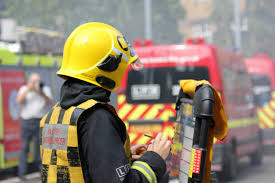My wife and I recently celebrated our 30 year wedding anniversary with a trip to Ireland. To say it was an unbelievably fun trip would be an understatement. I won’t bore you with the details, but instead will summarize with a few words; Guinness, Bushmills, golf, combat driving, blown tires, old castles, music and fun loving people.
One of the things I was able to do was visit a Northern Ireland Fire and Rescue Service Station in the small town of Warrenpoint. A friend of our host is a career NIFRS firefighter, and graciously gave me a tour of the station and equipment. My observations;
• The rigs (“appliances”) are much smaller than U.S. rigs, and for good reason. Ireland roads are NARROW. How narrow you ask? Let’s put it this way, I had to replace two tires on my rental car during the trip.
• They use hose rolls, not preconnects.
• They carry lots of equipment for MVA extrication. No big surprise here.
• Each appliance carries a long (approximate 50’) three fly extension ladder with tormentor poles.
• They are “well connected” from a communications standpoint, with mobile data computers, GPS tracking and pre-incident plans. Each station (or group of stations) has a civilian IT database person who maintains the electronic files.
• Like U.S. firefighters, they don’t like standing around outside the fire building in support roles. They’d much rather be slugging it out inside.
Specific to that last point, one area where they appear to be light years ahead of us is breathing air management. I had already heard that United Kingdom firefighters are very conservative and cautious when conducting interior fire operations using SCBA, and based on the monitoring equipment I saw, the NIFRS is equally conservative.
They use Draeger SCBA’s equipped with telemetry, which sends vital information about the status of the SCBA wearer and air levels to an electronic monitor board outside the building. Before firefighters enter an IDLH environment, a firefighter is assigned to control entry and monitor each SCBA in use by using the board. This position, called an Entry Control Officer (ECO), is responsible for monitoring the air level in each SCBA , and responding to any PASS alarm activations.
Each PASS alarm contains a small radio, sending telemetry about the status of the SCBA to an electronic control board monitored by the ECO. The ECO can also trigger the PASS alarm from the control board as required (to signal abandon the building for example). It is a pretty slick system.
Of course, you have to have someone dedicated to monitoring the system at all times, and as we all know in the fire service, manpower is at a premium, especially in the first few minutes. The NIFRS has not been spared from budget reductions, and staffing on appliances has been reduced. However, the ECO position remains a critical position that is filled before an SCBA is used. The US fire service could learn a few things from our partners across the pond. Thanks to NIFRS firefighter Conan O’neil for showing an old fire chief around.
 It's Not My Emergency Retired Crisis Manager's Brain Dump
It's Not My Emergency Retired Crisis Manager's Brain Dump
